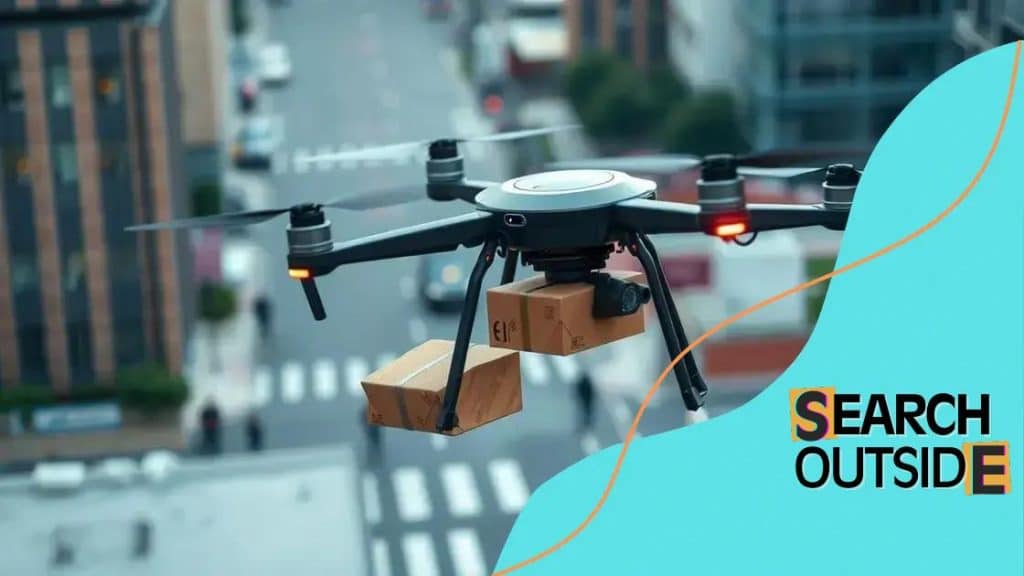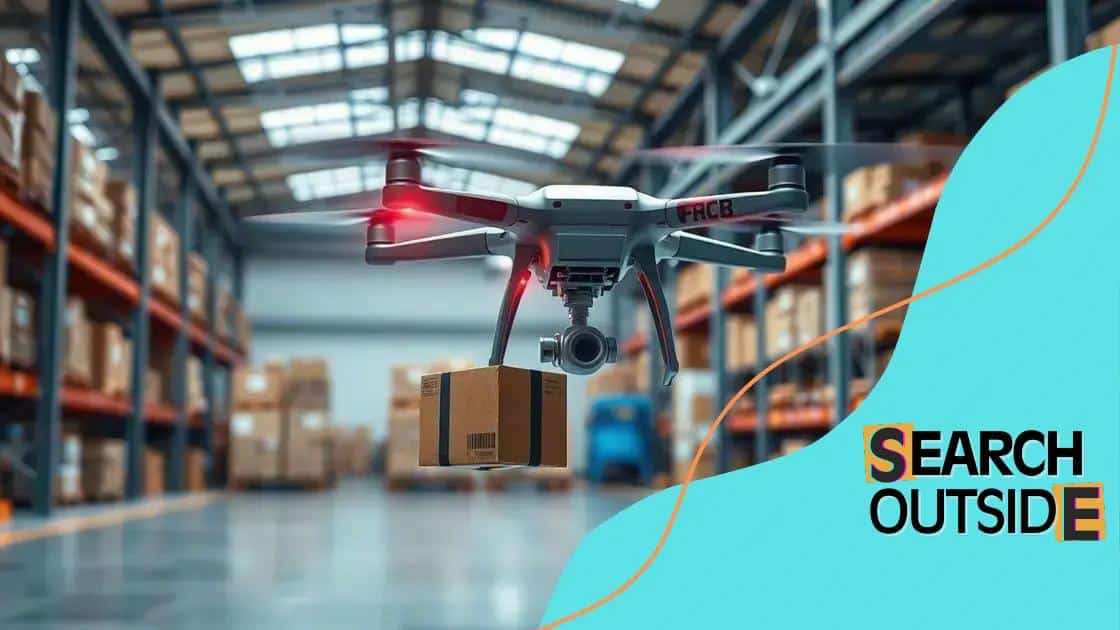How autonomous drones are revolutionizing delivery services

Autonomous drones are revolutionizing delivery services by providing faster, cost-effective, and eco-friendly solutions while addressing challenges such as regulations and public perception.
How autonomous drones are revolutionizing delivery services is a topic capturing attention. Imagine receiving your order at your doorstep in minutes! This innovation is changing how we think about deliveries and convenience. Are you curious about what this means for you?
Understanding autonomous drone technology
Autonomous drone technology is a fascinating field that blends aerodynamics and artificial intelligence. These drones can navigate and deliver packages without human intervention. Understanding how they work can help us appreciate their role in modern delivery systems.
How Do Autonomous Drones Work?
At their core, autonomous drones use a combination of sensors, cameras, and GPS systems to navigate. This means they can:
- Identify obstacles and avoid collisions.
- Map their environment for efficient routing.
- Receive real-time data to make flight decisions.
This technology is evolving rapidly, allowing drones to adapt to changing situations during flights. The integration of machine learning enables drones to improve their performance over time.
Key Features of Autonomous Drones
There are several notable features that make autonomous drones effective:
- Long-range capabilities: Drones are designed to cover large distances without the need for constant pilot guidance.
- Speed and efficiency: Drones can deliver packages faster than traditional delivery methods.
- Cost-effectiveness: Automated systems reduce labor costs and can streamline operations.
Furthermore, with advancements in battery technology, the flight time and distance covered by drones continue to increase, making them more efficient than ever.
In urban areas, autonomous drones are equipped to navigate complex landscapes, ensuring safe and timely deliveries. They rely on sophisticated algorithms that analyze data in real-time to select the best routes, avoiding crowded areas or bad weather conditions.
The Impact on Delivery Services
The implementation of autonomous drones is transforming delivery services. Businesses are exploring new ways to enhance customer satisfaction, and drones play a crucial role. By harnessing new technology, companies can:
- Reduce delivery times significantly.
- Offer innovative solutions to enhance user experience.
- Expand their reach to remote areas.
As we move forward, it’s clear that understanding autonomous drone technology is essential. These advancements not only revolutionize logistics but also open new possibilities for the future.
Benefits of drone delivery services
The benefits of drone delivery services are transforming the logistics industry. These services aim to provide faster and more efficient delivery options. By embracing this innovative technology, businesses can significantly enhance customer satisfaction.
Speed of Delivery
One of the main advantages of using drones is their speed. Drones can quickly navigate urban environments and bypass typical traffic conditions. This allows for:
- Faster delivery times.
- Immediate response to customer needs.
- Quick delivery of essential items.
In urgent situations, such as medical emergencies, drone deliveries can save lives by ensuring that critical supplies reach their destination as quickly as possible.
Cost Efficiency
Another important benefit is the cost reduction associated with drone delivery services. Businesses can lower their operational costs in various ways:
- Reducing labor expenses by minimizing the need for delivery drivers.
- Decreasing fuel costs compared to traditional delivery vehicles.
- Optimizing supply chain logistics.
These cost savings can be passed on to customers, making businesses more competitive in the market.
Moreover, drones require less maintenance than traditional vehicles, contributing to further savings. As technology advances, the initial investment in drone infrastructure becomes more affordable and beneficial for many companies.
Environmental Impact
The environmental benefits of using drones for deliveries are also significant. Drones produce fewer emissions compared to delivery trucks and vans. This shift towards sustainable practices can lead to:
- Reduced carbon footprints.
- Less traffic congestion in urban areas.
- Implementation of eco-friendly delivery solutions.
Utilizing drones helps support global efforts to combat climate change while improving delivery services.
The use of drone delivery services is evolving, and customer acceptance is growing. As these technologies continue to develop, we can anticipate even more benefits in efficiency and sustainability.
How drones are transforming logistics

Drones are revolutionizing logistics by offering innovative solutions tailored to modern delivery challenges. With their unique capabilities, these flying machines are reshaping how goods are transported and delivered.
Enhanced Efficiency
One of the key ways drones are transforming logistics is through enhanced efficiency. Drones can significantly reduce the time it takes to deliver packages. They can avoid traffic and take direct routes, which leads to:
- Faster deliveries to customers.
- Improved supply chain operations.
- Heightened customer satisfaction.
By streamlining delivery processes, companies can respond quickly to demand, minimizing delays and ensuring that products reach their destinations almost immediately.
Cost Reduction
In addition to speed, drones bring about considerable cost savings in logistics. By lowering delivery costs, businesses gain a competitive edge. The key cost benefits include:
- Reduced fuel consumption compared to trucks.
- Lower labor costs due to fewer drivers needed.
- Decreased operational overhead.
These savings can help businesses invest more in customer services and technology enhancements, creating a win-win situation.
Moreover, as drone technology progresses, hardware and maintenance costs are decreasing, making it easier for businesses to adopt this method of delivery.
Real-time Tracking and Data Usage
Drones also enable real-time tracking of deliveries. This capability allows logistics companies to monitor packages closely and provide accurate information to customers. With tracking systems, companies can:
- Provide updates on delivery status.
- Reduce uncertainties in the delivery process.
- Enhance overall transparency.
As a result, customers feel more in control and secure about their purchases. The ability to monitor shipments boosts confidence and reliability in logistics.
Through these advancements, drones are not just supplementary tools; they are becoming an integral part of logistics strategies across various industries. Their impact is felt in enhanced communication, resource management, and operational capabilities.
Challenges faced by drone delivery
Despite the significant advancements in drone technology, there are still many challenges faced by drone delivery services. Understanding these challenges is essential for anyone involved in or interested in this growing field.
Regulatory Issues
Regulations governing drone usage vary widely across regions. This inconsistency can complicate operations. Key regulatory challenges include:
- Different airspace rules in various countries.
- Restrictions on flying over populated areas.
- Challenges obtaining necessary permits and certifications.
These regulations are crucial for ensuring safety, but they can slow down the deployment and expansion of drone delivery networks.
Technical Limitations
Another major challenge is the technical limitations of drone technology. Drones must overcome several obstacles to become fully operational for deliveries. Some of these limitations include:
- Battery life, which can affect flight duration.
- Payload capacity, which limits the size of packages that can be delivered.
- Weather conditions impacting flight safety and reliability.
As technology evolves, these challenges may soon be addressed, but they currently hinder widespread adoption.
Public Perception and Acceptance
The acceptance of drones by the public poses another challenge. Many people have concerns regarding safety and privacy. Addressing these perceptions is important. To gain acceptance, the industry needs to:
- Educate the public about safety measures.
- Showcase successful delivery operations.
- Engage with communities to discuss benefits and safety.
Overcoming public skepticism will be vital for the growth of drone delivery services.
Logistical Challenges
Last but not least, logistical challenges persist in integrating drone deliveries into existing supply chains. Issues such as:
- Routing and scheduling for efficient deliveries.
- Coordination with traditional delivery services.
- Managing return logistics for undelivered items.
By addressing these logistical hurdles, businesses can maximize the potential of drone delivery, providing faster and more efficient services to customers.
Future trends in drone deliveries
The future trends in drone deliveries are promising as technology continues to advance. Drones are set to become a vital part of our delivery systems, shaping how we receive goods.
Increased Automation
One big trend is increased automation in delivery operations. As drones become more sophisticated, they will be able to operate with less human oversight. This change will lead to:
- Improved delivery efficiency.
- Cost reductions in logistics.
- Faster response times for consumer needs.
With advanced algorithms, drones will be capable of making real-time decisions, optimizing routes, and ensuring timely deliveries.
Integration with Smart Technology
Another significant trend is the integration of drones with smart technology, such as the Internet of Things (IoT). This connection will allow:
- Seamless communication between drones and delivery systems.
- Enhanced tracking and monitoring of packages.
- Data sharing for better logistics management.
This synergy will help companies streamline their operations and provide better services to customers.
Eco-Friendly Solutions
The move toward more eco-friendly solutions is also shaping the future of drone deliveries. Drones are naturally more environmentally friendly than traditional delivery vehicles. As companies focus on sustainability, we can expect:
- Increased use of electric drones.
- Investments in green technologies.
- Lower carbon emissions in package delivery processes.
These eco-conscious approaches will not only benefit the environment but also improve a company’s public image.
Expansion into Urban Areas
As urban populations grow, drones will increasingly be deployed in cities. Urban delivery presents unique opportunities and challenges. More drones in cities will likely mean:
- Innovative solutions for navigating crowded spaces.
- New delivery models, including on-demand services.
- Collaborations with local governments to establish air traffic regulations.
This shift will reshape urban logistics, leading to quicker and more convenient delivery options for city dwellers.
Overall, the future of drone deliveries is bright, with trends indicating significant advancements that will enhance service quality and efficiency. Staying ahead of these trends will be crucial for companies looking to leverage the potential of drone technology.
In conclusion, the future of drone deliveries holds exciting potential for both consumers and businesses. As technology continues to evolve, we can expect faster, more efficient, and eco-friendly delivery options. With increased automation and smart technology integration, drone deliveries are set to become a common practice. Overcoming challenges such as regulations and public perception will be crucial in this journey. Overall, embracing these advancements will lead to significant improvements in logistics and enhance customer experiences.
\n
\n
FAQ – Frequently Asked Questions about Drone Deliveries
How do drone deliveries improve customer satisfaction?
Drone deliveries provide faster service and timely responses, which boosts overall customer satisfaction.
What are the main challenges faced by drone delivery services?
Key challenges include regulatory issues, technical limitations, public perception, and logistical hurdles.
Are drone deliveries environmentally friendly?
Yes, drones use less energy and produce fewer emissions compared to traditional delivery vehicles.
What is the future of drone deliveries?
The future includes increased automation, integration with smart technology, and expansion into urban areas.





